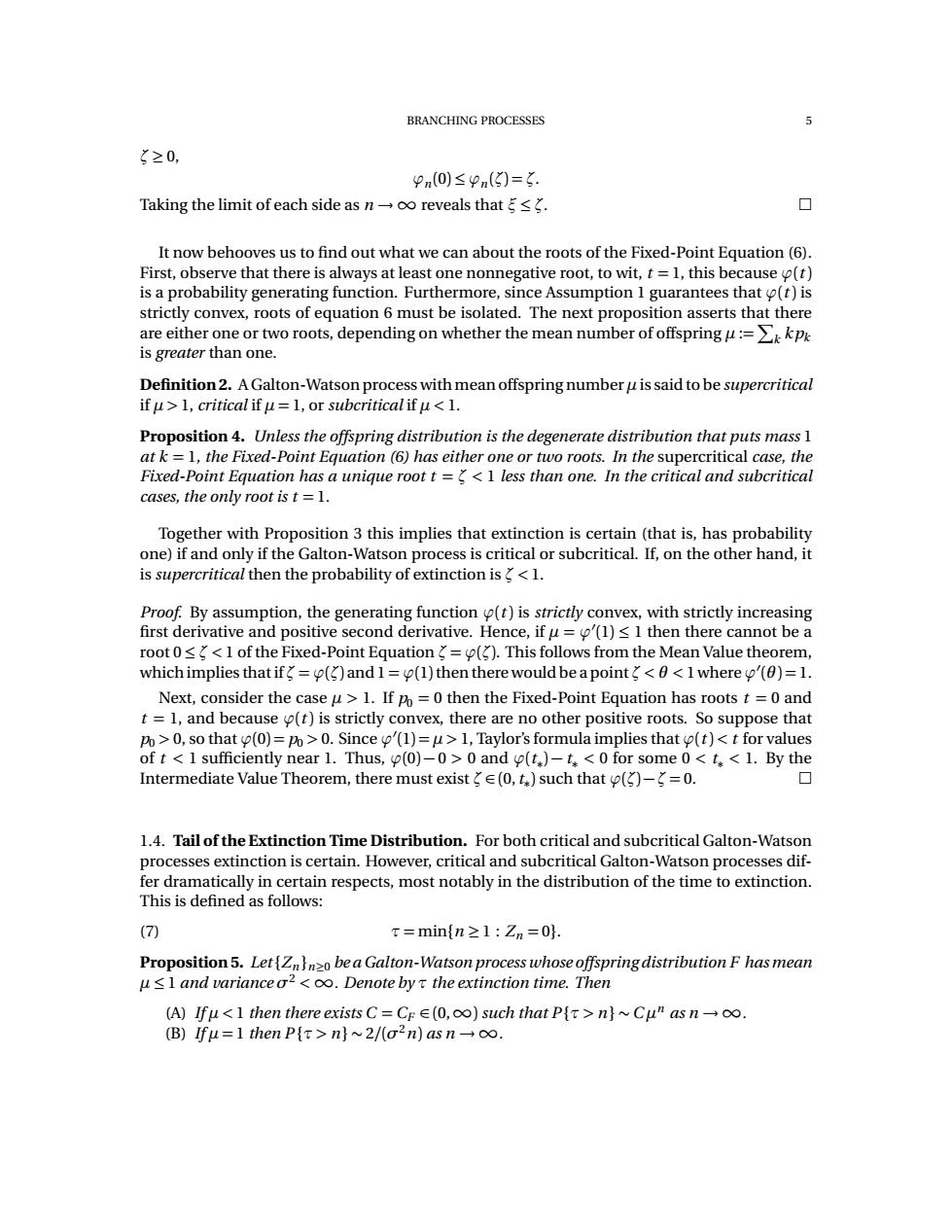正在加载图片...

BRANCHING PROCESSES 3≥0, 9n(0)≤pn(3)=3 Taking the limit of each side as n→o reveals thatξ≤y. 0 It now behooves us to find out what we can about the roots of the Fixed-Point Equation(6). First,observe that there is always at least one nonnegative root,to wit,t=1,this because o(t) is a probability generating function.Furthermore,since Assumption 1 guarantees that (t)is strictly convex,roots of equation 6 must be isolated.The next proposition asserts that there are either one or two roots,depending on whether the mean number of offspring u:=>kkpk is greater than one. Definition 2.A Galton-Watson process with mean offspring number u is said to be supercritical if u>1,critical ifu=1,or subcritical if u<1. Proposition 4.Unless the offspring distribution is the degenerate distribution that puts mass 1 at k =1,the Fixed-Point Equation (6)has either one or two roots.In the supercritical case,the Fixed-Point Equation has a unique root t=<1 less than one.In the critical and subcritical cases,the only root is t =1. Together with Proposition 3 this implies that extinction is certain(that is,has probability one)if and only if the Galton-Watson process is critical or subcritical.If,on the other hand,it is supercritical then the probability of extinction is<1. Proof.By assumption,the generating function (t)is strictly convex,with strictly increasing first derivative and positive second derivative.Hence,if u=(1)<1 then there cannot be a root0s<1 of the Fixed-Point Equation=().This follows from the Mean Value theorem, whichimplies that if=()and 1=(1)then there would be apoint<<1where ()=1. Next,consider the case u>1.If po =0 then the Fixed-Point Equation has roots t=0 and t =1,and because (t)is strictly convex,there are no other positive roots.So suppose that po>0,so that (0)=po >0.Since (1)=u>1,Taylor's formula implies that o(t)<t for values of t 1 sufficiently near 1.Thus,(0)-0>0 and (t,)-t,<0 for some 0<t,1.By the Intermediate Value Theorem,there must exist(0,t)such that ()=0. 口 1.4.Tail of the Extinction Time Distribution.For both critical and subcritical Galton-Watson processes extinction is certain.However,critical and subcritical Galton-Watson processes dif- fer dramatically in certain respects,most notably in the distribution of the time to extinction. This is defined as follows: (7) t=min{n≥1:Zn=0}. Proposition 5.Let{Zn}nzo be a Galton-Watson process whose offspring distribution F has mean u<1 and variance o2<oo.Denote byt the extinction time.Then A)Ifμ<1 then there exists C=Cr∈(0,o)such that P{r>n}~Cμ"asn→oo. (B)Ifu=1 then P(t>n)~2/(o2n)as nooBRANCHING PROCESSES 5 ζ ≥ 0, ϕn (0) ≤ ϕn (ζ) = ζ. Taking the limit of each side as n →∞ reveals that ξ ≤ ζ. It now behooves us to find out what we can about the roots of the Fixed-Point Equation (6). First, observe that there is always at least one nonnegative root, to wit, t = 1, this because ϕ(t ) is a probability generating function. Furthermore, since Assumption 1 guarantees that ϕ(t ) is strictly convex, roots of equation 6 must be isolated. The next proposition asserts that there are either one or two roots, depending on whether the mean number of offspring µ := P k k pk is greater than one. Definition 2. A Galton-Watson process with mean offspring numberµis said to be supercritical if µ > 1, critical if µ = 1, or subcritical if µ < 1. Proposition 4. Unless the offspring distribution is the degenerate distribution that puts mass 1 at k = 1, the Fixed-Point Equation (6) has either one or two roots. In the supercritical case, the Fixed-Point Equation has a unique root t = ζ < 1 less than one. In the critical and subcritical cases, the only root is t = 1. Together with Proposition 3 this implies that extinction is certain (that is, has probability one) if and only if the Galton-Watson process is critical or subcritical. If, on the other hand, it is supercritical then the probability of extinction is ζ < 1. Proof. By assumption, the generating function ϕ(t ) is strictly convex, with strictly increasing first derivative and positive second derivative. Hence, if µ = ϕ 0 (1) ≤ 1 then there cannot be a root 0 ≤ ζ < 1 of the Fixed-Point Equation ζ = ϕ(ζ). This follows from the Mean Value theorem, which implies that if ζ = ϕ(ζ) and 1 = ϕ(1)then there would be a point ζ < θ < 1 where ϕ 0 (θ ) = 1. Next, consider the case µ > 1. If p0 = 0 then the Fixed-Point Equation has roots t = 0 and t = 1, and because ϕ(t ) is strictly convex, there are no other positive roots. So suppose that p0 > 0, so that ϕ(0) = p0 > 0. Since ϕ 0 (1) = µ > 1, Taylor’s formula implies that ϕ(t ) < t for values of t < 1 sufficiently near 1. Thus, ϕ(0) − 0 > 0 and ϕ(t∗ ) − t∗ < 0 for some 0 < t∗ < 1. By the Intermediate Value Theorem, there must exist ζ ∈ (0,t∗ ) such that ϕ(ζ) − ζ = 0. 1.4. Tail of the Extinction Time Distribution. For both critical and subcritical Galton-Watson processes extinction is certain. However, critical and subcritical Galton-Watson processes differ dramatically in certain respects, most notably in the distribution of the time to extinction. This is defined as follows: (7) τ = min{n ≥ 1 : Zn = 0}. Proposition 5. Let {Zn }n≥0 be a Galton-Watson process whose offspring distribution F has mean µ ≤ 1 and variance σ2 <∞. Denote by τ the extinction time. Then (A) If µ < 1 then there exists C = CF ∈ (0,∞) such that P {τ > n} ∼ C µ n as n →∞. (B) If µ = 1 then P {τ > n} ∼ 2/(σ2n) as n →∞.��